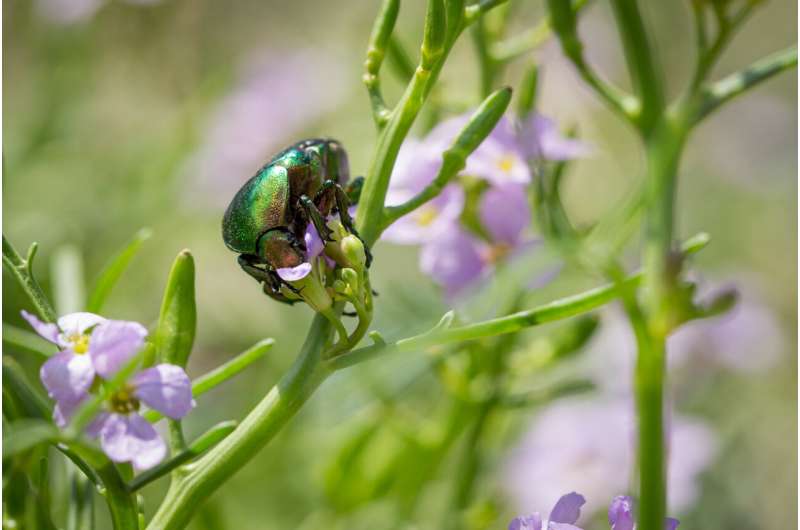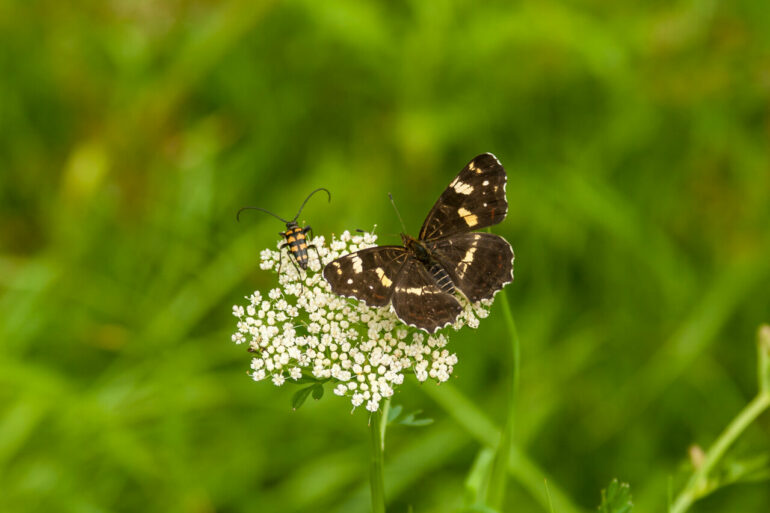Observations of abundance changes in one group of insects—for example grasshoppers—say very little about how other types of insects, such as flies, are doing, even in the same place. This is because different groups of insects may show similar trends in one place, but dissimilar trends in other places. These are the findings of a new meta-study systematically examining long-term data on insects from more than 900 locations worldwide. The study, published in Biology Letters, was led by a team of researchers from the German Centre for Integrative Biodiversity Research (iDiv), the Martin Luther University Halle-Wittenberg (MLU), the Friedrich Schiller University Jena and the Helmholtz Centre for Environmental Research (UFZ). It highlights the importance of monitoring multiple groups of species simultaneously to provide guidelines for conservation policies.
The decline in insect numbers became part of the global conversation in 2017, when scientists reported the loss of three-quarters of the flying insect biomass from western German nature reserves over 30 years. This made people realize there just weren’t as many bugs around as there used to be. An explosion of studies from across the world has emerged since, often showing large declines, prompting hundreds of popular articles about the insect decline problem.
Since 2018, a group of scientists led by iDiv, MLU, the University of Jena and the UFZ has been building and analyzing a database of studies from across the world that had monitored the abundances of groups of insects over multiple years. This group is led by Dr. Roel van Klink, postdoctoral researcher at iDiv and MLU. “The fact that such declines happened right under our noses, but no one saw that this phenomenon is occurring in many places, is quite alarming,” says van Klink. “It shows just how important it is to monitor our environment.”
But monitoring insects is challenging due to their small size and high diversity. In Germany alone, there are 30,000 species of insects. Second author Dr. Diana Bowler adds, “Most monitoring programs only study one insect group, but no one has investigated whether the status of the group under study tells us anything about the well-being of other insects.” Bowler is a postdoctoral researcher at iDiv, the University of Jena and the UFZ.

Insects are monitored because they inform about the health of ecosystems. They also play important roles in ecosystems. This flower chafer, for instance, pollinates wildflowers. © Oliver Thier
In their latest publication, van Klink and colleagues wanted to know whether changes in one type of insect could predict changes in other kinds of insects. For example, if butterflies decline, does that mean beetles, flies and bees decline, too? When changes in one group of species can predict the changes in other groups, they can be used as indicators, which would be useful, because then not all insect species would need to be monitored. If this is the case, it would give scientists and policymakers a simple way to use information from one group of insects to make conclusions and recommendations about all insects.
However, van Klink and colleagues found little evidence for indicator species in their analyses. Abundances of different groups of species showed different trends. “Trends of beetles and butterflies were the most similar, often increasing or decreasing together, but even their relationship was quite poor,” says van Klink. “But grasshoppers are just out there doing their own thing, with their abundances through time unrelated to those of other groups of species,” he adds.
Overall, the results of this study emphasize what the team has been saying for years. “Insects are not a homogeneous group of organisms, all showing dramatic declines across the world, as some headlines would have us believe,” says Prof Jonathan Chase, research group head at iDiv and MLU, and senior author of the study.
“Nature just isn’t as simple as we would like it to be,” van Klink adds. He continues, “No doubt humans are having unprecedented impacts on the natural world around us, and it’s our job to find out exactly how, why and where these changes occur, and to which kinds of insects.”
The scientists hope that their work emphasizes the need to monitor and better understand changes in abundances of a broad range of insect groups through time.
“We cannot simply monitor one group of insects and assume all the others do the same,” says Diana Bowler. “We need to care about the whole diversity of insects.”
More information:
Roel van Klink et al, Long-term abundance trends of insect taxa are only weakly correlated, Biology Letters (2022). DOI: 10.1098/rsbl.2021.0554
Provided by
German Centre for Integrative Biodiversity Research (iDiv) Halle-Jena-Leipzig
Citation:
While some insects are declining, others might be thriving (2022, February 22)



